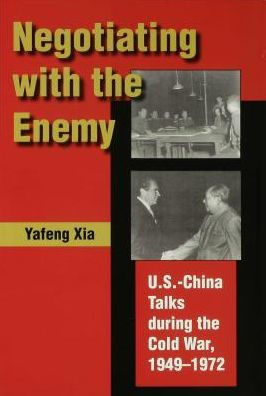Universityof Virginia - Jian Chen
Negotiating with the Enemy deals with a crucial issue concerning the history of Chinese—American relations, U.S. policy toward China, and in a more general sense the international history of the Cold War. Well organized and clearly written, the account rests on the author's excellent multi—archival and multi—source research. Strongly recommended.
Chinese Ambassador to the United States - Zhou Wenzhong
This is a very good attempt by Xia Yafeng to give a coherent and consistent account of the China—U.S. contacts during the early decades of the Cold War. The extensive research he has done is impressive and his readers will certainly gain a better understanding of this interesting and intricate part of the history of the relationship between the two great countries.
Piedmont Virginia Community College - C. W. Haury
Yafeng Xia (Long Island Univ.) has penned a complex scholarly account on a simple question: how did two adversaries, the US and the People's Republic of China (PRC), turn around that relationship over the course of the period from 1949 to 1972 in a diplomatic revolution engineered by Mao Zedong and Richard Nixon? Employing newly available Chinese archival information, Xia painstakingly crafts the story from the turbulent year 1949 to Nixon's China trip in 1972. While scholars might be disappointed that little attention is given to the State Department's 'China hands' who courageously offered advice about establishing a relationship with Mao before the takeover of the mainland, they will find information on those officials of the PRC, including Huang Hua, Wang Bingnan, and Qiao Guanhua, who advised Mao and Zhou Enlai as 'American hands.' In short, Xia sees the two—decades—plus story of Sino—US relations as a continuum of confrontation and communication that slowly paved the way for the historic changes in 1972. Despite security concerns, ideology, and historical enmity, the eventual conciliation resulted in full diplomatic recognition of the PRC in 1978. The book contains photos, a chronology, endnotes, and an especially noteworthy, extensive bibliography. Summing Up: Highly recommended. All levels/libraries. —CHOICE January 2008
William Burr
Drawing on newly available Chinese and U.S. primary sources, Yafeng Xia has produced a significant study on the complex and fascinating history of Beijing—Washington communications from the dangerous years of confrontation to the period of rapprochement forged by Mao and Nixon.
William Burr]]>
Drawing on newly available Chinese and U.S. primary sources, Yafeng Xia has produced a significant study on the complex and fascinating history of Beijing—Washington communications from the dangerous years of confrontation to the period of rapprochement forged by Mao and Nixon.



